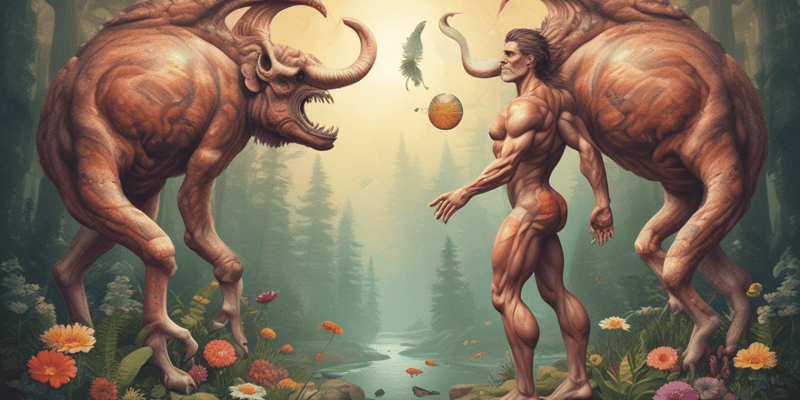10 Questions
What observation led Darwin to hypothesize that separate species may have arisen from an original ancestor?
Characteristics of many plants and animals varying greatly among the islands
Who wrote the essay 'On the law which regulated the introduction of new species' in 1855?
Alfred Russell Wallace
What is the title of the book written by Alfred Russell Wallace and dedicated to Charles Darwin?
The Malay Archipelago
What is the result of individuals in a population producing more offspring than can survive, according to Darwin and Wallace's theory?
Competition for limited resources
What is the primary mechanism driving the evolution of species, according to Darwin and Wallace's theory?
Natural selection
What is the name of the theory that describes the gradual evolution of species over time, as proposed by Alfred Russell Wallace?
The Sarawak Law
What is the term used to describe the process by which individuals best suited to their environment are more likely to survive and reproduce?
Survival of the fittest
What is the result of the 'struggle for existence' in a population, according to Darwin and Wallace's theory?
Competition for limited resources
What is the term used to describe the process by which the most 'fit' organisms pass their favorable traits to their offspring?
Heritable variation
What event precipitated the publishing of Charles Darwin's 'On the Origin of Species'?
The receipt of a letter from Alfred Russell Wallace
Study Notes
Evolution
- Evolution is the change in living things over a long period of time, including both changes within species and the origin of new species.
- All natural forms arose from their ancestors and adapted over time to their environments, leading to variation.
Types of Evolution
- Convergent Evolution: unrelated species exposed to the same selective pressure or shared environment tend to develop the same adaptations, e.g. bats and birds, placental wolf and Tasmanian wolf, sharks and whales.
- Divergent Evolution: related species evolve under different selective pressures, developing different adaptations as they diverge, e.g. Asian elephant and African elephant, tiger and lion, Darwin's finches, Hawaiian honeycreepers.
The Origins of Evolutionary Thought
- Creationism: all forms of life were created in their present form and remained unchanged since the beginning.
- Catastrophism: described the succession of fossils in soil layers, with the extinction of most plants and animals resulting from violent and catastrophic events, e.g. floods, droughts, earthquakes, and volcanic eruptions.
- Gradualism: geological change occurred slowly and continuously through processes such as erosion, sedimentation, earthquake, and volcanic activity.
- Uniformitarianism: geological processes at present operated similarly in the past, at about the same rate, concluding that Cuvier's catastrophism theory was wrong.
- Population Growth: people tend to have more children than can possibly survive, and human populations have historically been kept in check by famine, war, and disease.
Lamarckism
- Desire to change: an inborn urge to better themselves, innate tendency toward complexity and perfection.
- Inheritance of acquired traits: if an animal acquired a body structure during its lifetime, it could pass that change to its offspring.
- Believed that creatures develop new organs or change the structure and function of old ones, e.g. Lamarck's giraffe.
Darwinism
- Proposed by Charles Darwin and Alfred Russell Wallace.
- Based on the idea of Natural Selection.
- Natural Selection: process by which individual organisms with favorable traits are more likely to survive and reproduce than those with unfavorable traits.
Charles Darwin and Alfred Russell Wallace
- Charles Darwin: proposed the theory of evolution through natural selection, voyage on the HMS Beagle from 1831-1836, observed an incredible diversity of species, and collected many species of plants, animals, and fossils.
- Alfred Russell Wallace: explored in Asia, came to the same conclusion as Darwin, wrote 'The Malay Archipelago' (1869), and developed his thoughts into an essay 'On the law which regulated the introduction of new species' (1855).
Theory of Evolution by Natural Selection
- Individuals in a population show variation.
- Organisms produce more offspring than can survive, resulting in competition for limited resources, e.g. food, space, water, mates, etc.
- Individuals best suited or adapted to their environment are more likely to survive (Survival of the fittest).
- The most "fit" (reproductive success) organism passes their favorable traits to their offspring.
Learn about the definition and types of evolution, the origin of evolutionary thought, and the principle of evolution by natural selection. Explore the transformation of living things over time and the adaptation of species.
Make Your Own Quizzes and Flashcards
Convert your notes into interactive study material.
Get started for free



